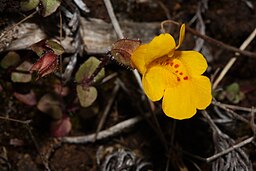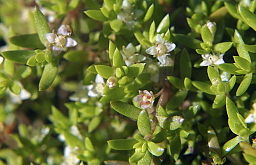 |
Canadian waterweed, pondweed | Status LU: established. 1st record: LU & ITW ~1875 |
 |
Kanadesch Waasserpescht | Status Eur.: established. 1st record: IE 1836. |
 |
Élodée du Canada | RA: ISEIA: A3 – Black List. Harmonia+: 0,46 |
 |
Kanadische Wasserpest | Wikipedia:     | Wikispecies: | Wikispecies:  | CABI | CABI |
 |
Brede waterpest | Back to the list of neophytes |
Contents
Brief description
Elodea canadensis Michx. is an aquatic plant native to North America that thrives in a variety of freshwater habitats, from still to slow-flowing systems and from very shallow to deep waters. It is most frequent in clear, nutrient-rich and alkaline waters. Elodea aggressively invaded the waterways of Europe in the 19th Century (Branquart et al. 2010).
Status and distribution in Luxembourg
Records of Elodea canadensis Michx. in Luxembourg. Data source: Recorder-Lux, iNaturalist & GBIF, 2025-08-02.
Elodea canadensis Michx. was introduced around 1875 to the Grand Duchy of Luxembourg in 2 ponds between Itzig, Contern and Scheidhof (Fischer 1882: 122). In the following years, it was found in Imbringen (1883), Meysembourg (1886), Schrassig (1902), Diekirch (1906), Birelergrund (1908) and Bissen (1909). Sunnen (1918: 10) mentions the Canadian pondweed in Brasseur’s pond, located on the Outer Ring of Luxembourg’s Old Town.
The Canadian waterweed has become quite common in our regions and can be observed in both standing and river waters (Diederich 1984: 38).
The oldest herbarium specimen in the Museum was collected in 1883 by Jean Feltgen (1833-1904) in standing water in the meadows of Imbringen (Specimen № 629a MNHNL 2000-).
Until 1909 the species had not been observed in the Ardennes (Oesling) (Robert 1910: 15).
By now the Canadian waterweed is widely spread throughout the country (MNHNL, iNaturalist & GBIF 2019).
The North American plant Elodea canadensis was introduced to Europe around 1835 and quickly invaded the fresh waters of much of the continent. However, this expansion seems to have stopped or even reversed today, and is tending to be replaced by Elodea nuttallii (Planch.) H. St. John (Lambinon & Verloove 2012: 790, 791).
Risk assessment
ISEIA protocol
A3 (3+3+3+3) = Black List (Ries et al. 2013: 18).
Harmonia+ protocol
Overall risk score 0,46 = (Overall Invasion score 0,77 x Overall Impact score 0,60) (Ries et al. 2020).
 Invasion
Invasion0,60

 Impact
Impact0,46

 Risk
RiskWorldwide distribution
Bibliography
- Branquart, E., I. Stiers, L. Triest, S. Vanderhoeven, W. Van Landuyt, F. Van Rossum, F. Verloove, 2010. Harmonia database: Elodea canadensis Michx.. Harmonia version 1.2, Belgian Forum on Invasive Species. URL: http://ias.biodiversity.be [accessed on 2019-10-09]
- CABI, 2019. Elodea canadensis. In: Invasive Species Compendium. Wallingford, UK: CAB International. URL: www.cabi.org/isc [accessed 2020-02-28]
- Diederich, P., 1984. Les monocotylédones aquatiques (excl. Potamogeton s.l.) du Grand-Duché de Luxembourg. Dumortiera 29-30: 34-41. [PDF 5 MB].
- Fischer, M.-E., 1882. Plantes phanérogames nouvelles ou rares de la flore luxembourgeoise. Recueil des mémoires et des travaux publiés par la Société de botanique du grand-duché de Luxembourg 6-8: 116-124.
- Lambinon J. & F. Verloove, 2012. Nouvelle flore de la Belgique, du grand-duché de Luxembourg, du Nord de la France et des régions voisines. Sixième édition. Avec la collaboration de L. Delvosalle, B. Toussaint, D. Geerinck, I. Hoste, F. Van Rossum, B. Cornier, R. Schumacker, A. Vanderpoorten et H. Vannerom. Jardin botanique national de Belgique, Meise. CXXXIX + 1195 pp. ISBN : 9789072619884.
- MNHNL, 2000-. Elodea canadensis Michx. in Recorder-Lux, database on the natural heritage of the Grand Duchy of Luxembourg. Musée national d’histoire naturelle, Luxembourg. URL: https://mdata.mnhn.lu [Accessed 2019-09-05]
- MNHNL, iNaturalist & GBIF, 2019. Elodea canadensis Michx. in MNHNL-mdata, online portal combining species observation from Recorder-Lux, iNaturalist and GBIF. National Museum of Natural History, Luxembourg. URL: https://mdata.mnhn.lu [Accessed 2019-09-06]
- Oly, M., 2022. Kartierung invasiver gebietsfremder Wasserpflanzen im Großherzotum Luxemburg, Untersuchungen zur Verbreitung von invasiven gebietsfremden Wasserpflanzen in einer beispielhaften Auswahl an Stillgewässern, Musée national d’histoire naturelle, Luxembourg. 117 pp.
- Ries, C. & Y. Krippel, 2021. First records of 56 invasive alien vascular plants in Luxembourg. Bulletin de la Société des naturalistes luxembourgeois 123: 115-127. [PDF 241 KB]
- Ries, C., Y. Krippel & M. Pfeiffenschneider, 2020. Risk assessment after the Harmonia+ protocol of invasive alien vascular plant species in Luxembourg. Bull. Soc. Nat. luxemb. 122: 197-205. [PDF 132 KB]
- Ries, C., Y. Krippel, M. Pfeiffenschneider & S. Schneider, 2013. Environmental impact assessment and black, watch and alert list classification after the ISEIA Protocol of non-native vascular plant species in Luxembourg. Bull. Soc. Nat. luxemb. 114: 15-21. [PDF 652 KB]
- Robert, J., 1910. Beiträge zur Flora des Grossherzogtums Luxemburg. lnst. G.-D. Lux., Sect. Sc. natur., phvs., math., Arch. trimestr. n.s. V: 1-35. Luxembourg: Imprimerie de la Cour Victor-Buck.
- Sunnen, M., 1918. Die Stechmückenplage in Luxemburg und Umgebung. P. Worré-Mertens, Luxembourg, 24 p. [PDF 80 MB]
Page content last updated on 2023-08-17. Last proofread by Caroline Grounds on 2019-11-14.

















